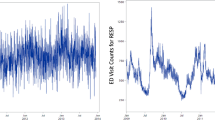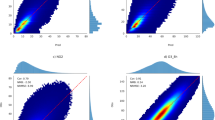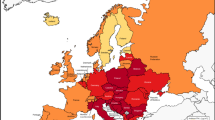Abstract
Because of practical problems associated with measurement of personal exposures to air pollutants in larger populations, almost all epidemiological studies assign exposures based on fixed-site ambient air monitoring stations. In the presence of multiple monitoring stations at different locations, the selection of them may affect the observed epidemiological concentration–response (C-R) relationships. In this paper, we quantify these impacts in an observational ecologic case–crossover study of air pollution and mortality. The associations of daily concentrations of PM10, O3, and NO2 with daily all-cause non-violent mortality were investigated using conditional logistic regression to estimate percent increase in the risk of dying for an increase of 10 μg/m3 in the previous day air pollutant concentrations (lag 1). The study area covers the six main cities in the central-western part of Emilia-Romagna region (population of 1.1 million). We used four approaches to assign exposure to air pollutants for each individual considered in the study: nearest background station; city average of all stations available; average of all stations in a macro-area covering three cities and average of all six cities in the study area (50 × 150 km2). Odds ratios generally increased enlarging the spatial dimension of the exposure definition and were highest for six city-average exposure definition. The effect is especially evident for PM10, and similar for NO2, whereas for ozone, we did not find any change in the C-R estimates. Within a geographically homogeneous region, the spatial aggregation of monitoring station data leads to higher and more robust risk estimates for PM10 and NO2, even if monitor-to-monitor correlations showed a light decrease with distance. We suggest that the larger aggregation improves the representativity of the exposure estimates by decreasing exposure misclassification, which is more profound when using individual stations vs regional averages.
This is a preview of subscription content, access via your institution
Access options
Subscribe to this journal
Receive 6 print issues and online access
$259.00 per year
only $43.17 per issue
Buy this article
- Purchase on Springer Link
- Instant access to full article PDF
Prices may be subject to local taxes which are calculated during checkout





Similar content being viewed by others
References
Anderson H.R., Atkinson R.W., and Peacock J.L., et al. Meta-analysis of time-series studies and panel studies of particulate matter (PM) and ozone (O3). Report of a WHO task group. Copenhagen: WHO Regional Office for Europe 2004. Available at http://www.euro.who.int/document/e82792.pdf.
Bell M.L., McDermott A., Zeger S.L., Samet J.M., and Dominici F. Ozone and short-term mortality in 95 US urban communities, 1987–2000. JAMA 2004: 292 (19): 2372–2378.
Biggeri A., Baccini M., Accetta G., Bellini A., and Grechi D. Quality assessment of air pollutants concentration in epidemiologic time series on short-term effects of pollution on health. Epidemiol Prev 2003: 27: 365–375.
Biggeri A., Bellini P., and Terracini B. Meta-analysis of the Italian studies on short-term effects of air pollution. Epidemiol Prev 2004: 28 (Suppl.): S1–100.
Bland J.M., and Altman D.G. Statistical methods for assessing agreement between two methods of clinical measurement. Lancet 1986: 1: 307–310.
Bureau Veritas. UK Equivalence Programme for Monitoring of Particulate Matter. BV/AQ/AD202209/DH/2396 2006 2006.
Carroll R.J, Ruppert D, and Stefanski L.A Measurement Error in Nonlinear Models. Chapman and Hall, London, 1995.
Forastiere F., Stafoggia M., and Berti G., et al. Particulate matter and daily mortality a case-crossover analysis of individual effect modifiers. Epidemiology 2008: 19 (4): 571–580.
Halonen J.I., Lanki T., Yli-Tuomi T., Tiittanen P., Kulmala M., and Pekkanen J. Particulate air pollution and acute cardiorespiratory hospital admissions and mortality among the elderly. Epidemiology 2009: 20 (1): 143–153.
Hänninen O.O., Alm S., Katsouyanni K., Künzli N., Maroni M., Nieuwenhuijsen M.J., Saarela K., Srám R.J., Zmirou D., and Jantunen M.J. The EXPOLIS study: implications for exposure research and environmental policy in Europe. J Expo Anal Environ Epidemiol 2004: 14 (6): 440–456.
Hastie T.J., and Tibshirani R.J. Generalized Additive Models. Chapman and Hall, London, UK, 1990.
Ito K., De Leon S., Thurston G.D., Nádas A., and Lippmann M. Monitor-to-monitor temporal correlation of air pollution in the contiguous US. J Expo Anal Environ Epidemiol 2005: 15 (2): 172–184.
Ito K., Thurston G.D., Nádas A., and Lippmann M. Monitor-to-monitor temporal correlation of air pollution and weather variables in the North-Central US. J Expo Anal Environ Epidemiol 2001: 11 (1): 21–32.
Janssen N.A., Hoek G., Brunekreef B., Harssema H., Mensink I., and Zuidhof A. Personal sampling of particles in adults: relation among personal, indoor, and outdoor air concentrations. Am J Epidemiol 1998: 147: 537–547.
Kalkstein L.S., and Valimont K.M. An evaluation of summer discomfort in the United States using a relative climatological index. Bull Am Meteorol Soc 1986: 67: 842–848.
Katsouyanni K., Schwartz J., and Spix C., et al. Short term effects of air pollution on health: a European approach using epidemiologic time series data: the APHEA protocol. J Epid Comm Health 1996: 50 (Suppl. 1): 12–18.
Koistinen K.J., Hänninen O.O., Rotko T., Edwards R.D., Moschandreas D., and Jantunen M.J. Behavioral and environmental determinants of personal exposures to PM2.5 in EXPOLIS-Helsinki, Finland. Atmos Environ 2001: 35 (14): 2473–2481.
Kousa A., Oglesby L., Koistinen K., Kunzli N., and Jantunen M. Exposure chain of urban air PM2.5—associations between ambient fixed site, residential outdoor, indoor, workplace, personal exposures in four European cities in the EXPOLIS-study. Atmos Environ 2002: 36: 3031–3039.
Lee D., and Shaddick G. Time-varying coefficient models for the analysis of air pollution, health outcome data. Biometrics 2007: 63 (4): 1253–1261.
Lin L. A concordance correlation coefficient to evaluate reproducibility. Biometrics 1989: 45: 255–268.
Lipfert F.W., and Wyzga R.E. Air pollution and mortality: the implications of uncertainties in regression modeling and exposure measurement. J Air Waste Manag Assoc 1997: 47 (4): 517–523.
Maclure M. The case-crossover design: a method for studying transient effects on the risk of acute events. Am J Epidemiol 1991: 133: 144–153.
Michelozzi P., De Sario M., Accetta G., de′Donato F., Kirchmayer U., D’Ovidio M., Perucci C.A., and HHWWS Collaborative Group Temperature and summer mortality: geographical and temporal variations in four Italian cities. J Epidemiol Community Health 2006: 60 (5): 417–423.
Nawrot T.S., Torfs R., Fierens F., De Henauw S., Hoet P.H., Van Kersschaever G., De Backer G., and Nemery B. Stronger associations between daily mortality and fine particulate air pollution in summer than in winter: evidence from a heavily polluted region in western Europe. J Epidemiol Community Health 2007: 61 (2): 146–149.
Ostro B., Broadwin R., Green S., Feng W-Y., and Lipsett M. Fine particulate air pollution and mortality in nine California counties: results from CALFINE; environ. Health Perspect 2006: 114: 29–33.
Peng R.D., Dominici F., Pastor-Barriuso R., Zeger S.L., and Samet J.M. Seasonal analyses of air pollution and mortality in 100 US cities. Am J Epidemiol 2005: 161 (6): 585–594.
Pope C.A., and Dockery D. Health effects of fine particulate air pollution: lines that connect. J Air Waste Manag Assoc 2006: 56: 709–742.
Samet J.M., Dominici F., Zeger S., Schwartz J., and Dockery D.W. The National Morbidity, Mortality, and Air Pollution Study (NMMAPS). Part 1. Methods and Methodological Issues. Health Effects Institute, Cambridge, MA, 2000a.
Samet J.M, Zeger S., and Dominici F. et al. The National Morbidity, Mortality, and Air Pollution Study (NMMAPS). Part 2. Morbidity, Mortality, and Air Pollution in the United States. Health Effects Institute, Cambridge, MA, 2000b.
Samoli E., Aga E., Touloumi G., Nisiotis K., Forsberg B., Lefranc A., Pekkanen J., Wojtyniak B., Schindler C., Niciu E., Brunstein R., Dodic Fikfak M., Schwartz J., and Katsouyanni K. Short-term effects of nitrogen dioxide on mortality: an analysis within the APHEA project. Eur Respir J 2006: 27 (6): 1129–1138.
Schwartz J. The distributed lag between air pollution and daily deaths. Epidemiology 2000: 11: 320–326.
Thomas D., Stram D., and Dwyer J. Exposure measurement error: influence on exposure-disease relationships and methods of correction. Annu Rev Public Health 1993: 14: 69–93.
Wallace L. Indoor particles: a review. J Air Waste Manag Assoc 1996: 46: 98–126.
WHO Working Group. Health Aspects of Air Pollution with Particulate Matter, Ozone and Nitrogen Dioxide. WHO, Bonn, Germany, 2003 EUR/03/5042688. Available at http://www.euro.who.int/document/e79097.pdf.
WHO. 2006. WHO Air Quality Guidelines, Global Update 2005. Copenhagen, Denmark, WHO Regional Office for Europe. Available at: www.euro.who.int/Document/E90038.pdf (accessed 10 June 2010).
Wilson W.E., and Brauer M. Estimation of ambient and non-ambient components of particulate matter exposure from a personal monitoring panel study. Appendix B1 B1: quality assurance. J Expo Sci Environ Epidemiol 2006: 16: 264–274.
Wilson W.E., and Suh H.H. Fine particles and coarse particles: concentration relationships relevant to epidemiologic studies. J Air Waste Manag Assoc 1997: 47: 1238–1249.
Zauli Sajani S., Tibaldi S., Scotto F., and Lauriola P. Bioclimatic characterisation of an urban area: a case study in Bologna (Italy). Int J Biometeorol 2008: 52 (8): 779–785.
Zeger S.L., Thomas D., and Dominici F., et al. Exposure measurements error in time-series studies of air pollution: concepts and consequences. Environ Health Perspect 2000: 108 (5): 419–426.
Author information
Authors and Affiliations
Corresponding author
Ethics declarations
Competing interests
The authors declare no conflict of interest.
Rights and permissions
About this article
Cite this article
Zauli Sajani, S., Hänninen, O., Marchesi, S. et al. Comparison of different exposure settings in a case–crossover study on air pollution and daily mortality: counterintuitive results. J Expo Sci Environ Epidemiol 21, 385–394 (2011). https://doi.org/10.1038/jes.2010.27
Received:
Accepted:
Published:
Issue Date:
DOI: https://doi.org/10.1038/jes.2010.27
Keywords
This article is cited by
-
Study on the Sensitivity Indicators by Sandstorm PM10 Exposure
Toxicology and Environmental Health Sciences (2018)



